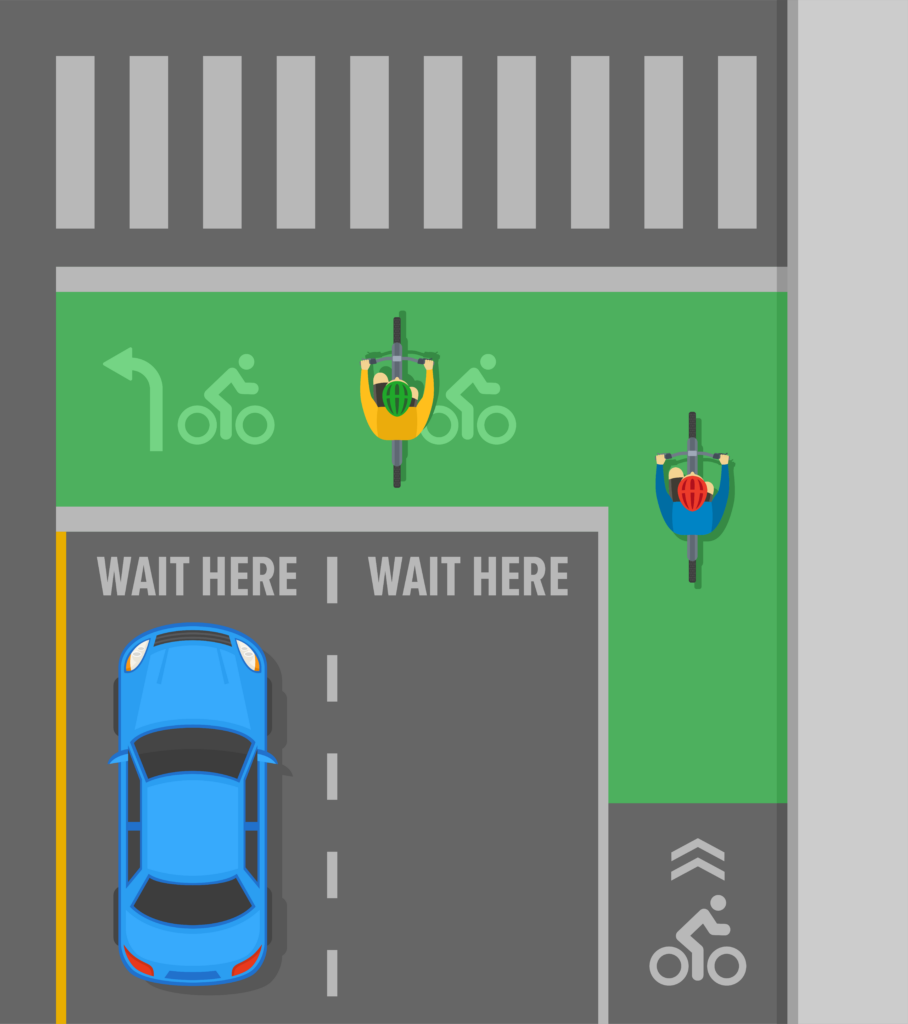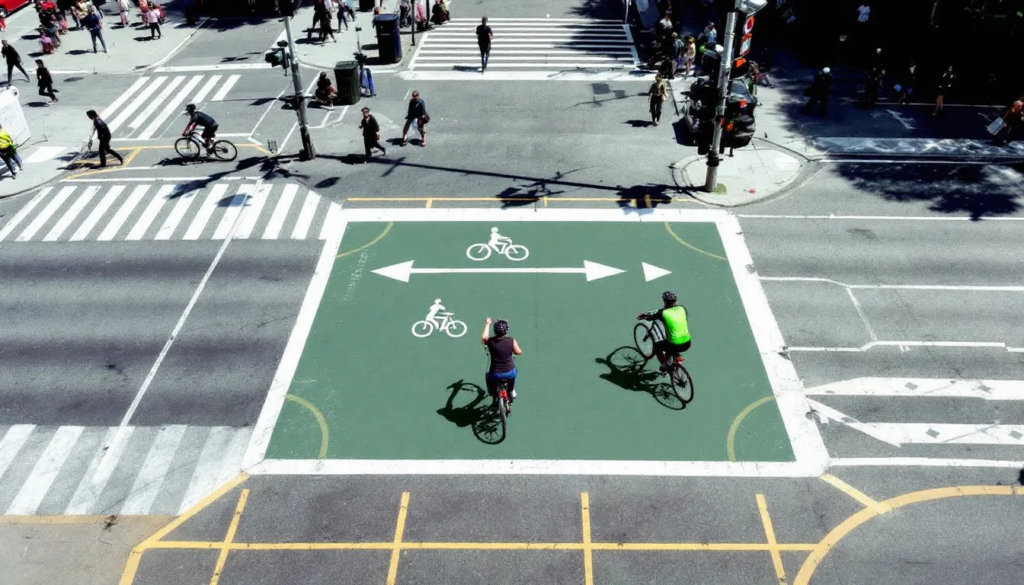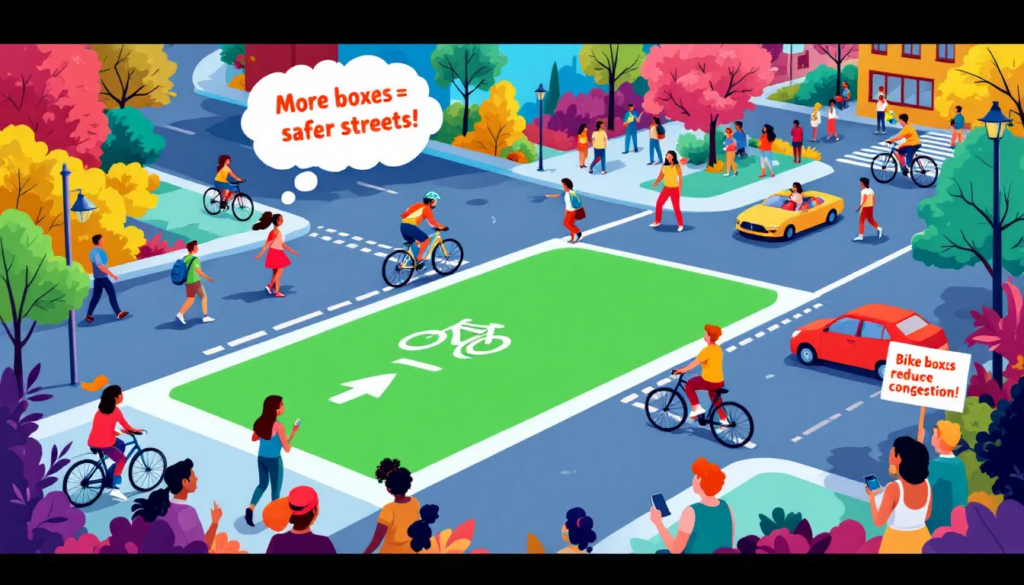A bike box at intersections is a designated area that allows cyclists to wait in front of cars at a red light. This improves their visibility and reduces the risk of accidents. In this article, we will detail what is bike box at intersections, how bike boxes work, their safety benefits, and best practices for cyclists and drivers.
Key Takeaways
Bike boxes improve cyclist visibility and safety at intersections by allowing them to wait in front of vehicles at red signals, reducing collision risks.
Proper usage of bike boxes involves cyclists entering from designated lanes and positioning themselves correctly, while drivers must yield and avoid obstructing these areas.
The adoption of bike boxes has expanded in urban areas, leading to a significant decrease in cyclist accidents, with studies showing reductions in collisions by up to 65%.
Understanding Bike Boxes
Bike boxes are designated areas at signalized intersections that enhance bicycle safety by allowing cyclists to position themselves in front of motorists at red signals. This simple yet effective design helps cyclists get to the front of the traffic line, significantly enhancing their visibility and overall safety. Positioned between the stop line for motor vehicles and the pedestrian crosswalk, these boxes are usually painted bright green for high visibility, ensuring that both drivers and cyclists are aware of the space.
The primary purpose of bike boxes is to reduce the likelihood of accidents involving bicycles and motor vehicles. Allowing cyclists to wait in front of vehicles makes them more visible to drivers, reducing the chances of collisions at intersections. This increased visibility is crucial at busy intersections where the risk of accidents is higher due to the convergence of multiple traffic streams.
Bike boxes were first introduced in the Netherlands in the late 1990s, a period that saw a significant rise in cycling traffic in urban areas. The Dutch, known for their innovative approaches to cycling infrastructure, developed bike boxes to address the growing need for cyclist safety at intersections. Over the years, the design of bike boxes has evolved, adapting to the varying needs of different cities and improving traffic management.
Now, let’s break down how bike boxes work in practice and the operational nuances that make them an effective safety measure.
How Bike Boxes Operate
Understanding how bike boxes operate is key to appreciating their benefits. These green boxes provide a clear and designated space for cyclists to position themselves at intersections, increasing their visibility to drivers. When the traffic signal is red, cyclists can move into the bike box area ahead of motor vehicles. This positioning allows cyclists to be clearly seen by drivers, reducing the risk of accidents when the signal changes to green.
Most bike boxes are designed to work in conjunction with bike lanes, allowing cyclists to approach the intersection safely and smoothly. As the light turns green, cyclists can start moving ahead of motor vehicles, giving them a head start and reducing the likelihood of conflicts with turning vehicles. This early start is particularly beneficial in preventing right-hook accidents, where a vehicle turns right across the path of a cyclist going straight.
Moreover, bike boxes facilitate safer left turns for cyclists. Instead of merging across multiple lanes of traffic, cyclists can position themselves in the bike box and make their left turn when the light changes, without the need to navigate through moving vehicles. This feature is especially useful in busy urban settings where traffic density can make merging difficult and hazardous.
In summary, bike boxes work by providing a safe, visible space for cyclists at intersections, allowing them to start moving before vehicles and facilitating safer turns. This design not only enhances cyclist safety but also contributes to smoother and more predictable traffic flow.
The Evolution of Bike Boxes
The concept of bike boxes has come a long way since its inception. Originating in the Netherlands in the late 1990s, bike boxes were developed as a solution to improve cyclist safety at intersections. The rise in urban cycling and the need for better traffic management led to the creation of these designated areas, which have since become a staple in many cities around the world.
The design and implementation of bike boxes have evolved to address the unique needs of different urban areas. Initially, they were simple painted areas, but over time, additional features such as dedicated bike signals and enhanced markings have been added to improve their effectiveness. The success of bike boxes in the Netherlands inspired other countries to adopt similar measures, leading to a global spread of this safety feature.
Today, bike boxes are a common sight in many cities, serving as a testament to the effectiveness of innovative traffic solutions in enhancing cyclist safety. The evolution of bike boxes continues as cities experiment with new designs and technologies to further improve their functionality and integration into the urban landscape.
Adoption in the U.S.
The adoption of bike boxes in the United States began in the early 2000s, with cities like San Francisco and Portland leading the way. These cities recognized the need for safer cycling infrastructure and introduced bike boxes as part of their traffic management strategies. The implementation of bike boxes in these areas significantly promoted safer cycling practices and increased awareness of cyclist safety.
In places like Boca Raton, bike boxes were introduced to enhance safety after the removal of dedicated bike lanes. This strategic move aimed to provide cyclists with a safe space at intersections, compensating for the lack of continuous bike lanes. Urban areas with high densities of cyclists, such as those near public transit stations or schools, often see the installation of bike boxes to facilitate safer transitions across intersections.
These strategic placements are crucial in promoting multimodal transportation options and ensuring the safety of cyclists in high-traffic areas. Placing bike boxes near schools and parks encourages recreational cycling and ensures the safety of young and inexperienced cyclists.
The adoption of bike boxes in the U.S. has been a significant step towards creating safer, more cyclist-friendly cities. As more urban areas recognize the benefits of bike boxes, their implementation continues to grow, contributing to a safer and more efficient traffic environment for all road users.
Safety Benefits of Bike Boxes

The primary goal of bike boxes is to enhance the safety of cyclists at intersections, a critical point in urban traffic where accidents are more likely to occur. By increasing the visibility of cyclists, bike boxes reduce the likelihood of accidents involving vehicles and cyclists. This increased visibility is crucial, as many accidents occur when drivers fail to see cyclists at intersections.
Studies have shown that the introduction of bike boxes in urban areas leads to a significant decrease in cyclist accidents at intersections. For instance, data indicates that bike boxes can reduce bicycle-vehicle collisions by up to 65%. This reduction in accidents is primarily due to the enhanced visibility and dedicated space provided for cyclists, which minimizes conflicts with motor vehicles.
Moreover, bike boxes also contribute to pedestrian safety by reducing the chances of cyclists encroaching on crosswalks. Providing a clear and designated space for cyclists, bike boxes help maintain an orderly and predictable traffic flow, benefiting all road users.
Additionally, bike boxes facilitate safer left turns for cyclists, allowing them to position themselves effectively and avoid merging across multiple lanes of traffic. This feature is particularly beneficial in busy urban settings, where traffic density can make turning movements challenging and hazardous.
Proper Use of Bike Boxes by Cyclists

To maximize the safety benefits of bike boxes, it is essential for cyclists to use them correctly. Bike boxes are designated areas at traffic signals where cyclists can wait in front of motor vehicles, providing a clear and visible space for them at intersections. Cyclists should always approach bike boxes from the designated bike lane, ensuring that they enter the bike box area safely and predictably.
When stopping in a bike box, cyclists should position themselves in front of vehicles to enhance their visibility. This positioning helps drivers see cyclists clearly, reducing the chances of accidents when the light changes to green. It is also important for cyclists to be mindful of pedestrians and avoid blocking crosswalks when using bike boxes.
One of the significant advantages of bike boxes is that they allow cyclists to position themselves safely for left turns without having to merge across multiple lanes of traffic. This feature is particularly useful in busy urban environments, where traffic density can make merging challenging and dangerous.
Understanding how to use bike boxes correctly is essential for both cyclists and drivers to maximize safety. Cities like Portland have led the way in adopting bike boxes, providing extensive educational resources to ensure proper use and understanding among both cyclists and motorists. Following these best practices helps cyclists enhance their safety and contribute to a more harmonious traffic environment.
Drivers' Responsibilities at Bike Boxes
While bike boxes are designed to enhance cyclist safety, their effectiveness also depends on the cooperation of drivers. One of the primary responsibilities of drivers at bike boxes is to yield to cyclists in the designated area, particularly when the signal changes to green. This yielding behavior helps prevent right-turn collisions and ensures that cyclists can start moving safely without conflicts with motor vehicles.
Drivers must avoid stopping in bike boxes, as this can obstruct cyclists and lead to unsafe interactions. By staying behind the stop line, drivers can provide a clear and open space for cyclists, enhancing their visibility and safety. Making eye contact with cyclists can also help ensure that drivers see them and understand their intentions.
Understanding and respecting bike boxes is crucial for drivers to contribute to a safer traffic environment. By following these guidelines, drivers can help prevent accidents and ensure the safety of all road users, including cyclists.
Where You’ll Find Bike Boxes
Bike boxes are typically found at signalized intersections, where they are painted on the road between the stop line for motor vehicles and the pedestrian crosswalk. These designated areas provide a clear and visible space for cyclists to wait at red lights, enhancing their safety and visibility at critical points where traffic intersects, using uniform traffic control devices.
Most bike boxes are placed at busy intersections, where cyclists frequently encounter traffic and the risk of accidents is higher. By providing a dedicated space for cyclists at these intersections, bike boxes help reduce conflicts and improve safety for all road users.
In addition to busy urban intersections, bike boxes are also commonly found near schools, parks, and public transit stations. These strategic locations help promote safe cycling practices and encourage more people to use bicycles for their daily commutes and recreational activities.
Advocating for More Bike Boxes

Advocating for more bike boxes in your community can help enhance cyclist safety and promote a more bike-friendly environment. Cities with active cycling advocacy groups often prioritize locations for bike boxes based on community feedback and cycling patterns. By forming or joining a local bicycle advisory group, you can provide a platform for discussing and pushing for bike box installations.
Utilizing crowdsourcing tools and apps can help gather community input and build consensus for pedal-friendly infrastructure like bike boxes. Working with local media through blogs, social media, or press releases can amplify the message for more bike boxes in the community. Participating in or organizing events like ‘Bike to Work’ days can also raise awareness about the need for bike boxes and promote safer cycling practices.
Cycling advocacy groups can provide resources and support efforts for more bike boxes in your community. By collaborating with local cycling groups and city officials, cyclists can advocate for the installation of bike boxes and contribute to a safer and more bike-friendly urban environment.
Weighing the Pros and Cons
While bike boxes offer numerous benefits, it’s important to consider their potential drawbacks to ensure a balanced perspective. One of the main advantages of bike boxes is the increased safety and visibility they provide for cyclists at intersections. Giving cyclists a dedicated space at the front of the traffic line reduces conflicts between cyclists and motor vehicles, especially during the green signal phase. This separation of spaces can lead to smoother traffic flow and fewer accidents, ultimately benefiting all road users.
However, there are some potential issues associated with bike boxes that need to be addressed. For example, the implementation of bike boxes can lead to increased traffic congestion if not properly managed, as they may occupy valuable road space. This can be particularly problematic in areas with high volumes of traffic, where road space is already limited. Additionally, some motorists may face confusion regarding their right-of-way when bike boxes are present, which could lead to misunderstandings and potential conflicts.
Another concern is that bike boxes might encourage improper behavior among some riders who might misuse them. For instance, cyclists who do not follow the designated bike lanes to approach the bike box area can create unsafe situations for themselves and other road users. Ensuring proper education and enforcement is crucial to addressing these issues and maximizing the benefits of bike boxes.
Overall, the pros of bike boxes – such as increased safety, visibility, and reduced conflicts – generally outweigh the cons. However, careful planning, proper management, and continuous education are essential to mitigate any potential drawbacks and ensure the successful implementation of bike boxes in urban areas.
Ready to Ride?
Bike boxes are most beneficial in urban settings but can also improve safety at busy intersections in suburban areas. Providing a clear and visible space for cyclists at intersections helps reduce the risk of accidents and enhances overall traffic safety. Understanding how to use bike boxes correctly is essential for both cyclists and drivers to maximize these benefits.
As a cyclist, approaching a bike box from the designated bike lane and positioning yourself within the marked area is crucial. When the green light turns on, proceed straight or make your turn safely, ensuring that you avoid conflicts with motor vehicles and bicycle traffic in the traffic lane. By following these best practices, you can enhance your safety and contribute to a more harmonious traffic light environment.
Before:
Drivers also play a critical role in ensuring the effectiveness of bike boxes. Yielding to cyclists in the bike box area and avoiding stopping in the designated space helps drivers prevent accidents and ensure the safety of all road users. Making eye contact with cyclists can also help ensure that drivers see them and understand their intentions, further enhancing safety.
After:
Drivers play a critical role in ensuring the effectiveness of bike boxes by:
Yielding to cyclists in the bike box area.
Avoiding stopping in the designated space to prevent accidents.
Making eye contact with cyclists to enhance safety and understand their intentions.
So, are you ready to ride? Understanding and using bike boxes correctly enables both cyclists and drivers to contribute to a safer and more efficient traffic environment. Let’s work together to promote safer cycling practices and make our cities more bike-friendly.
Summary
In summary, bike boxes are a valuable tool for enhancing cyclist safety at intersections. By providing a clear and visible space for cyclists to wait in front of motor vehicles, bike boxes help reduce the risk of accidents and improve overall traffic flow. The adoption of bike boxes in cities around the world has shown significant benefits, including increased visibility, reduced conflicts, and enhanced safety for both cyclists and drivers.
As we move forward, it is essential to continue advocating for more bike boxes and promoting proper use and understanding among all road users. By working together, we can create safer, more bike-friendly urban environments and encourage more people to choose cycling as a sustainable and healthy mode of transportation.
Frequently Asked Questions
What is a bike box?
A bike box enhances cyclist visibility and safety at signalized intersections by providing a designated area for them to position themselves in front of motorists at red signals. It’s an important feature for safer urban cycling.
How do bike boxes improve safety?
Bike boxes improve safety by increasing cyclist visibility, which reduces the risk of accidents with vehicles. They also aid in safer left turns and promote smoother traffic flow.
Where are bike boxes commonly found?
Bike boxes are commonly found at busy intersections, near schools, parks, and public transit stations to enhance cyclist safety. Their placement in these areas prioritizes the well-being of cyclists amidst heavy traffic.
What should drivers do when encountering a bike box?
Drivers must yield to cyclists in the bike box and avoid stopping in that area to ensure safety for all road users. Making eye contact with cyclists can help clarify intentions and improve communication.
How can I advocate for more bike boxes in my community?
Advocating for more bike boxes in your community involves joining or creating a bicycle advisory group, gathering community input through crowdsourcing, and engaging local media to raise awareness. These actions will help build support for your initiative and encourage local authorities to take action.


